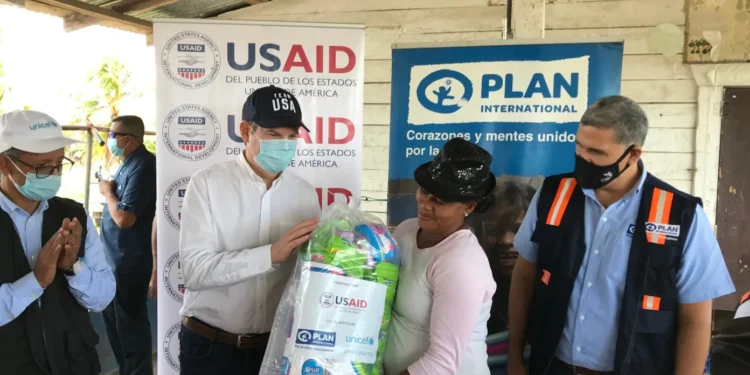US. President Donald Trump has just closed down USAID after Elon Musk branded it “a criminal organization,” adding “it’s time for it to die.” Is there any truth to Musk’s allegation?
By John Perry
One “beneficiary” of USAID is Nicaragua, a country with one of the lowest incomes per head in Latin America. Between 2014 and 2021, USAID spent US$315,009,297 on projects there.
Uninformed observers might suppose that this money helped poor communities, but they would be wrong. Most of it was spent trying to undermine Nicaragua’s government and, in the process, gave lucrative contracts to U.S. consultancies and to some of Nicaragua’s richest families.
USAID has been working in Nicaragua for decades, but this article focuses on the period 2014-2021. The story is not a pleasant one. The key element is the agency’s role in the coup attempt against Nicaragua’s Sandinista government in 2018 and, later, in trying to disrupt the country’s general elections in 2021.
Detailed information has been revealed by websites such as Nicaleaks, Tortilla con Sal and Behind Back Doors, but after 2021 many of the local “non-governmental” organizations USAID funded were closed (voluntarily in some cases, in others following resolutions by Nicaragua’s parliament). In the last few years, the agency’s operations, in Nicaragua at least, have become more obscure.
The last major operation that was exposed to the public gaze, via a leaked document, was called “RAIN” (“Responsive Assistance in Nicaragua”). If you ask Google’s AI assistant, Search Labs, what it is, you will be told that it provides rapid aid in response to natural disasters. But it does nothing of the sort.
It started with a $2 million program in 2020-2022 to try to ensure that the Sandinistas were defeated in the 2021 elections. I described the project here and an article by Ben Norton went into further detail. The contract, active until recently, is now recorded as worth $5 million and was extended at least to April 2024.
The RAIN contract was awarded to the Navanti Group, one of many large consultancies that have benefited from USAID’s Nicaraguan projects. Binoy Kampmark recently noted in CounterPunch that nine out of every ten dollars spent by USAID go to a limited number of consultancies, mostly based in Washington. Back in 2023, New Lines Magazine commented that “USAID and its massive budget have spurred a network of firms, lobbyists, academics and logistics personnel that would cease to exist without government funding.”
One such firm is Creative Associates International, a company described by Alan MacLeod in Mintpress News as “one of the largest and most powerful non-governmental organizations operating anywhere in the world,” its regime-change work has taken place in Cuba, Venezuela and elsewhere, mostly marked by failure. In Cuba alone it received $1.8 billion of USAID money. Then from 2018-2020, Creative Associates was awarded $7.5 million-worth of projects in Nicaragua. One, dubbed TVET SAY, was to train young opposition political leaders in towns on Nicaragua’s Caribbean coast so that they could engage more effectively with business leaders opposed to the government.
Manuel Orozco, a Nicaraguan organizer of the 2018 coup attempt, later became a director of Creative Associates. Now based in Washington, when he last planned to visit Nicaragua in June 2021, he was advised by USAID to cancel his trip as he risked being arrested for his role in the coup. Shortly afterwards he was formally accused of conspiracy by the Nicaraguan prosecutor.
Another large company, Dexis, which had $144 million of new contracts with USAID in 2024, ran a $9 million “Institutional strengthening program” in Nicaragua between 2013-2018. Its purpose was to help opposition leaders mobilize and to run media campaigns. In 2023, USAID audited Dexis contracts and found over $41 million of ineligible or unsupported costs.
Dexis subcontracted the Nicaraguan work to another US firm, Chemonics, which has 6,000 employees (“teammates”) and is USAID’s biggest contractor. It received awards of well over $1 billion in both 2023 and 2024, despite heavy criticisms of its previous work, for example in Haiti. Chemonics’s founder told the New York Times in 1993 that he created the firm to “have my own CIA.”
Two US consultancies had USAID contracts to promote anti-Sandinista opinion and instill antigovernment practices. DevTech Systems, a company awarded $45 million in USAID contracts in 2024, ran a $14 million education project on the Caribbean coast with these objectives, from 2013 to 2019. Global Communities, two-thirds of whose income ($248 million in 2023) comes from the US government, ran a similar, $29 million program.
Yet another large consultancy, the International Research and Exchange Board (IREX), formed close ties with one of Nicaragua’s richest families, the Chamorros. IREX has a global staff of 760 and over 80% of its $155 million income comes from the US government. It ran “media strengthening” programs in Nicaragua worth $10,300,000. Ticavision, a Costa Rican TV channel, recently reported that USAID is investigating the misuse of $158 million allocated through IREX to Nicaraguan projects, including this one. The money went to a number of well-known Nicaraguan journalists, now based abroad, including Confidencial’s Carlos Fernando Chamorro.
The Chamorro family, owners of the newspaper La Prensa and online outlet Confidencial, were the main beneficiaries of USAID in Nicaragua. The Violeta Barrios de Chamorro Foundation is named after a former president and run by her daughter, Cristiana Chamorro. It received $7 million in USAID funds to promote opposition media platforms, including those owned by the family. From this it disbursed smaller sums – typically $40,000 each – to other media organizations such as 100% Noticias and various radio and TV channels. But the bulk of the money stayed with the Chamorros.
All the media that received money were openly anti-Sandinista. In 2018, the owner of 100% Noticias, Miguel Mora incited a violent arson attack against Sandinista-supporting Radio Ya, from which the journalists barely escaped alive. Later he told Max Blumenthal of The Grayzone that the US should have intervened militarily to remove the Nicaraguan government. Mora was later welcomed at the White House by then vice-president Mike Pence.
Another Chamorro organization, the thinktank FUNIDES, was allegedly created by USAID and received $3,699,221 to run anti-government research projects. Its head was Juan Sebastián Chamorro (cousin of Cristiana and Carlos).
Yet another Chamorro thinktank, CINCO, headed by Carlos Fernando and opposition activist Sofía Montenegro, received $3,247,632. There is considerable evidence of close liaison between the Chamorros, Montenegro and US officials. For example, Montenegro received money directly from USAID and was also photographed at the US embassy; USAID representative Deborah Ullmer met Juan Sebastián Chamorro in October 2018 to discuss why the coup attempt had failed. Juan Sebastián was then head of one of the main opposition political parties, the Civic Alliance.
In total, it is estimated that the Chamorros benefitted personally to the tune of $5,516,578 in US government money. In 2022, Cristiana Chamorro was found guilty of money laundering (her eight-year sentence was commuted to house arrest; after a few months she was given asylum in the US).
Luciano García Mejía, a wealthy member of the family of the former dictator, Anastasio Somoza, was another beneficiary of Washington’s dollars. He ran another political pressure group, Hagamos Democracia (“Let’s make democracy”). This was funded partially by USAID but principally (with $1,114,000) by the CIA. Hagamos Democracia openly called for criminal acts during the coup attempt, recruited known criminals and directly threatened President Ortega to “look to his own and his family’s safety and leave without further repercussions.”
Other affluent Nicaraguans to receive USAID money included Mónica Baltodano who, through her Fundación Popol Na was paid $207,762. Similarly, Violeta Granera’s Movement for Nicaragua was paid $803,154. Both were opposition leaders; Granera later called for US sanctions against Nicaragua.
Not only did USAID fund and actively monitor the 2018 insurrection as it developed, but once it realized that the coup had failed, it began to undermine the 2021 elections. This was another failure, but the corporate media’s current depiction of Nicaragua as a “dictatorship” or an “authoritarian regime” is due in no small part to the work of the US government’s “aid agency.”
Very little of USAID’s work over the past eleven years benefitted ordinary Nicaraguans. Instead, millions of dollars were creamed off by wealthy consultants in Washington and wealthy oligarchs in Nicaragua. Evidence of fraud comes mainly from Nicaraguan government investigations but, as noted in the examples in this article, it fits within a pattern of US-government largesse with limited accountability and plentiful evidence of bad practice.
This is only a small part of the story in which the agency spent $315 millions in training and funding Nicaraguan opposition leaders who coordinated the violence and criminality of the 2018 coup attempt. In Nicaragua at least, the evidence arguably supports Musk’s contention that USAID is “a criminal organization.”
John Perry is based in Masaya, Nicaragua and writes for the Council on Hemispheric Affairs, London Review of Books, FAIR and elsewhere.
The original article can be found here
Source link : http://www.bing.com/news/apiclick.aspx?ref=FexRss&aid=&tid=67be9b24261d436c844f1995d7a5afcb&url=https%3A%2F%2Fwww.pressenza.com%2F2025%2F02%2Fis-usaid-a-criminal-organization-in-nicaragua-the-evidence-suggests-it-is%2F&c=9324209143796692710&mkt=en-us
Author :
Publish date : 2025-02-25 14:43:00
Copyright for syndicated content belongs to the linked Source.







